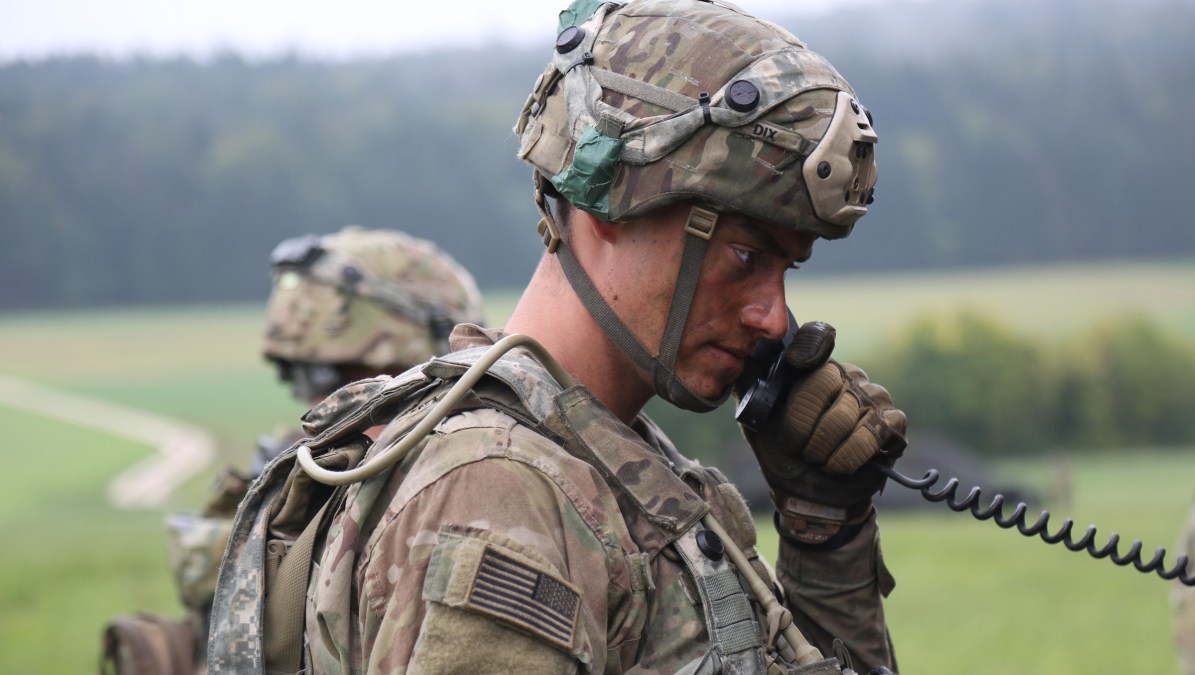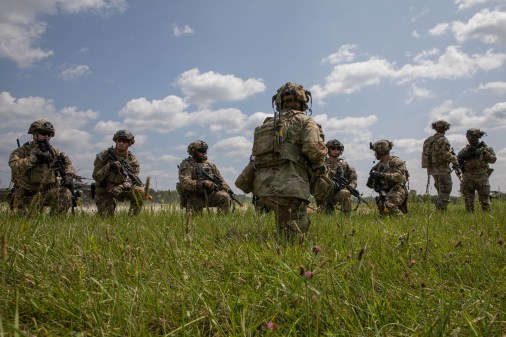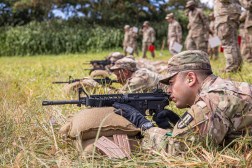Establishing communications at-the-halt may not be viable for most Army formations in future conflicts, program executive officer says

Army units at the brigade and below level might not be able to stop on the battlefield to establish communications or command posts given the expected fast-paced nature of future conflicts, according to one of the service’s key program executive officers.
“I bet you if I said, ‘Somebody out there define for me at-the-quick-halt,’ I bet a lot of you if you wrote it down, would say it’s 30 minutes or less,” Maj. Gen. Anthony Potts, PEO of Command, Control, Communications-Tactical, said at the annual SATELLITE conference on Wednesday. “Think orders of magnitude less than that.”
The Army’s new multi-domain doctrine provides a number “that you go, ‘Holy crap, that’s … like jumping out of the car 35 miles an hour. That’s not at-the-quick-halt.’ Now you’ve got to start thinking differently,” Potts said. “When you get down to the point where we really are talking at the brigade and below, we are really talking about not even having tactical operations centers that go stationary anymore. We just simply can’t do it. Not in that scale of conflict. Not with the capability that’s out on the battlefield, the capability to understand where you’re at, to target where you are through cyber capabilities … We’re just not going to stop.”
Officials are designing the network architecture to address the need for forces to be constantly moving on the battlefield, articulating a preference for on-the-move versus at-the-halt capabilities.
“I’ve told the team between at-the-halt and on-the-move, give me on-the-move because … with on-the-move [technology], if I am at-the-halt, I can use it, but if I only have a system that does it at-the-halt, I can’t do it on-the-move. This is a shift,” Potts explained.
One of the major takeaways from Russia’s previous incursion into Ukraine nearly a decade ago was their ability to locate Ukrainian command posts and fire upon them, based on detecting their electromagnetic signature.
The Army’s Russia New Generation Warfare study in 2017 spurred several modernization efforts still ongoing today, including the need to reduce the size and complexity of command posts.
It emphasized the notion that conflicts will be much faster paced and the large static command posts that were used by the U.S. military during its recent counterinsurgency fights would not be suitable. American forces must move much more quickly to avoid being located and targeted.
Most likely, for brigade and below units, they’ll be primarily using systems such as the Joint Battle Command-Platform and Mounted Mission Command as opposed to the Command Post Computing Environment, Potts said.
The Joint Battle Command-Platform is a friendly force tracking system, though Mounted Mission Command is the next-generation technology providing on the move communications, situational awareness, and command and control through tactical messaging, chat and instant message. The Command Post Computing Environment is a web-enabled system that will consolidate current mission systems and programs into a single user interface at command posts to provide a common operational picture.
“Not really till you get to the division [level] to where we’re looking at this idea that you can do limited stops for a period of time because of your distance from the forward line of troops,” Potts noted.
The Army is shifting to the division as the main unit of action going forward — a transition from the post-9/11 counterinsurgency era where the brigade was the primary unit — given the larger distances and increased capacity needed to fight against sophisticated nation states.
With the rapid nature of battle anticipated, the Army has begun down a path that in prior years would likely have been unheard of, but now is becoming more of a necessity: secure but unclassified capabilities and communications at battalion and below.
The Army, when initially designing the integrated tactical network, implemented a secure but unclassified capability, which is underpinned by encryption, as a means of allowing soldiers to move faster on the battlefield and share with partners easier. Oftentimes, classification can bog down information sharing and partnering in operations. But the Army determined that much of the tactical information is perishable and thus, doesn’t need the same rigorous classification to guard it in real-time.
“We are looking hard as an Army at the battalion below moving that to secure but unclassified for the vast majority of what happens in the battalion. That’s a paradigm shift. That is a big paradigm shift,” Potts said.
While this data is encrypted, Potts said it is not National Security Agency type 1 encryption. By not using type 1 encryption, Potts believes that could actually protect units even more from a signature management standpoint.
“I just want to look like everybody else. I don’t want to have a unique military signature out there,” he said. “Even if they can’t get in and see what’s inside of [a system], it’s such a unique signature that they go, ‘I don’t care, that’s a U.S. force sitting in a country right here where they don’t belong.’”
The Russians have demonstrated a keen ability to locate and ultimately target units and command posts – either with missiles or jamming tools – in Ukraine based solely on their electromagnetic signature.
Additionally, the Army is requiring transport agnostic systems and a more resilient architecture that has several fallbacks from the Earth and satellite constellations.
“Why are we talking about multiband, multi-orbit, on-the-move capabilities? Because that’s where we’re going as an Army,” Potts said. “It’s what we’re going to need to survive on the battlefield … We’ve got to get to the point where we are transport agnostic.”






